Information
Dahekou Cemetery of Western Zhou Dynasty found in Shanxi Province
Summary: Dahekou Cemetery of Western Zhou Dynasty found in Shanxi ProvinceFrom:Chinese ArchaeologyWriter:Date:2017-07-25The Dahekou cemetery is located in the Dahekou village, Yicheng County, Shanxi Province. During 2014 September and 2015 December, archaeological
Dahekou Cemetery of Western Zhou Dynasty found in Shanxi Province
From:Chinese Archaeology Writer: Date:2017-07-25
The Dahekou cemetery is located in the Dahekou village, Yicheng County, Shanxi Province. During 2014 September and 2015 December, archaeological team collaborated by the Shanxi Provincial Institute of Archaeology and Linfen Municipal Administration of Cultural Heritage conducted the excavation there. The excavation covered an area of over 3000 square meters where in total 1660 tombs and over 10800 pieces of archaeological assemblages were discovered.
Tombs
Tombs are major discoveries of this excavation. All of them are earth shaft tombs. Though the distribution of tombs lacks clear pattern, it seems certain degree of arrangement was applied. The shapes of tomb openings are rectangular with either round corners or sharp corners. The average depth of tombs is 3 m or slightly below. Only in a few of tombs, wall niches were constructed within which some ceramics were placed.
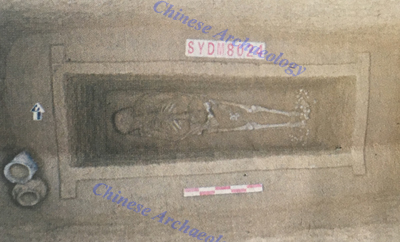
Tomb M8024
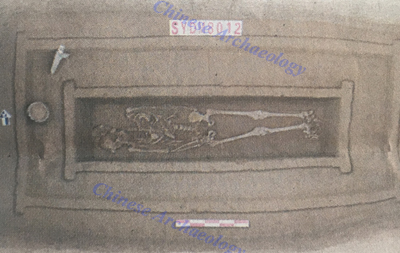
Tomb M8021
Most tombs contained single coffins while in tombs in the north part of the cemetery, there were double coffins or twin coffins recovered. There are traces of wood remains which indicate the shape and the structure of the coffins. Generally, the plan of the coffin is in a square shape resembling Chinese character ‘口’. In other cases, the wooden remnants are suggestive of coffin shapes alike the ‘l l’ character. Mortise and tenon joint was used in assembling coffins. In some tombs, there are wooden stands and waist pits underneath the coffins. Animal remains were occasionally found deposited in waist pits, among which dog bones were identified. Secondary platforms were discovered in most tombs, some of which were constructed using additional soil while the others were dug into the original wall.
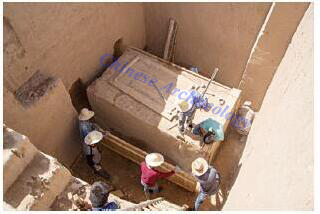
Archeological staff members work at the site of the Dahekou Cemetery
Human skeletons in tombs were placed with heads pointed to the west in general. There are also exceptions whose heads were placed towards east and north. Those people whose heads towards east were buried in tombs in the southeast part of the cemetery. Most skeletons were lying on their backs. Occasionally, traces of cloths were recovered on skeletons. No evidence of human sacrifice was found, which indicates that this funeral custom was not popular at this cemetery.
Funeral goods include ceramic, bronze artifact, shell tool, jade, bone tool, lacquer ware and tin ware, among which ceramics and shells comprise the majority. Ceramic types include li (tripod container), guan (jar), dou (stemmed dish), gui (bowl with handles), hu (pot), bo (bowl), pen (dish), bu (crock), lid, spinning wheel, knife and other decorative item. Li and guan vessels have the largest proportions and together formed a standard set for funeral goods.

Oracle bones(left) and painted pottery jar(right)
Bronze artifacts include ritual vessels, weapons, tool, accessories, chariot parts and so on. There are discoveries of ding (tripod vessel), gui (bowl with handles), li (tripod vessel), ge (knife), spear, arrowhead, ben (axes), chisel, bulb, fish, shell, ring, bell, needle, danglu (horse mask), horse bit, biao (bit attachment), xia (wheel spoke), wei (hub-end). There are 19 pieces of ritual vessels ding tripod, 1 gui bowl, 1 li tripod vessel. Ritual vessels were usually deposited on the secondary platforms or between the inner and outer coffins. Occasionally, they were buried around skeletons’ feet. Weapons, tools, decorative accessories and chariots parts were presented next to the skeletons. Sometimes they were found located on the secondary platforms or upon the coffin covers.
Shells are comprised of clams and marine shells. Clams were used for decoration. Some marine shells were put in the mouth of the skeleton, using as ‘han’, a ritual item put into the mouth of the dead. Shell tools were buried within the coffins or on the secondary platforms.
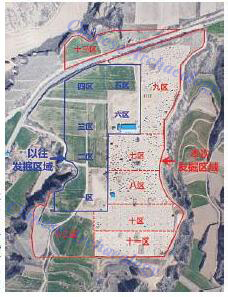
The aerial photot which illustrated the distribution of Dahekou Cemetery
Jades are very limited in number, the types of which include spinning wheel, axes, knife, ring and other decorative accessory. While tools were placed on the secondary platforms, decorations were arranged upon the dead’s bodies. Only a few of them were used as ‘han’, the jade in-mouth.
A small number of bone tools were also discovered including spinning wheels, arrowheads, combs, decorative accessory and oracle bones. Some were deposited on the secondary platforms whereas some were placed near the skeletons. The discovery of two oracle bones was a surprise during the excavation. Fragments of tin and lacquer ware were also collected.
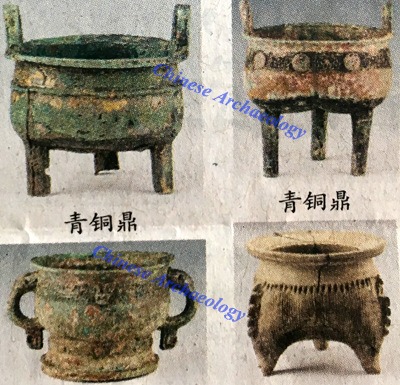
The bronzeware found in the Cemetery
Ash Pits and house foundations
There are in total 75 ash pits, most of which are bag-shaped. Pottery fragments, roughly dating to the Eastern Zhou Dynasty, were deposited in pits. Very likely, these pits were constructed for storage as hoards. However more evidence will be needed before any concrete conclusion can be asserted.
1 house foundation was recovered, comprising of a main chamber and a doorway. The main chamber is 260 cm long from east to west and 210 cm wide from north to south. The floor has hard surface. In the southeast corner of the chamber is located a well-preserved hearth. The filling soil within the house contained grey pottery fragments from dish and jar vessels. The dating is back to the Eastern Zhou Dynasty as estimated.
Significance
The Dahekou cemetery belonged to the Ba kingdom during the Western Zhou Dynasty. It dated back to from the early Western Zhou Dynasty to the beginning of the Spring and Autumn period. This excavation clearly demonstrates the range of the cemetery and the distribution of tombs. It has been the second attempt to excavate a kingdom cemetery of the Zhou Dynasty after the excavation at the Peng kingdom cemetery at Hengshui, Jiang County, Shanxi Province. So far there were totally over 2200 tombs and 25000 artifacts excavated. These data above provide significant clues to probe the history of kingdoms in southern Shanxi during the Western Zhou Dynasty. (Translator: Dong Ningning)
Tombs
Tombs are major discoveries of this excavation. All of them are earth shaft tombs. Though the distribution of tombs lacks clear pattern, it seems certain degree of arrangement was applied. The shapes of tomb openings are rectangular with either round corners or sharp corners. The average depth of tombs is 3 m or slightly below. Only in a few of tombs, wall niches were constructed within which some ceramics were placed.

Tomb M8024

Tomb M8021

Archeological staff members work at the site of the Dahekou Cemetery
Human skeletons in tombs were placed with heads pointed to the west in general. There are also exceptions whose heads were placed towards east and north. Those people whose heads towards east were buried in tombs in the southeast part of the cemetery. Most skeletons were lying on their backs. Occasionally, traces of cloths were recovered on skeletons. No evidence of human sacrifice was found, which indicates that this funeral custom was not popular at this cemetery.
Funeral goods include ceramic, bronze artifact, shell tool, jade, bone tool, lacquer ware and tin ware, among which ceramics and shells comprise the majority. Ceramic types include li (tripod container), guan (jar), dou (stemmed dish), gui (bowl with handles), hu (pot), bo (bowl), pen (dish), bu (crock), lid, spinning wheel, knife and other decorative item. Li and guan vessels have the largest proportions and together formed a standard set for funeral goods.

Oracle bones(left) and painted pottery jar(right)
Shells are comprised of clams and marine shells. Clams were used for decoration. Some marine shells were put in the mouth of the skeleton, using as ‘han’, a ritual item put into the mouth of the dead. Shell tools were buried within the coffins or on the secondary platforms.

The aerial photot which illustrated the distribution of Dahekou Cemetery
Jades are very limited in number, the types of which include spinning wheel, axes, knife, ring and other decorative accessory. While tools were placed on the secondary platforms, decorations were arranged upon the dead’s bodies. Only a few of them were used as ‘han’, the jade in-mouth.
A small number of bone tools were also discovered including spinning wheels, arrowheads, combs, decorative accessory and oracle bones. Some were deposited on the secondary platforms whereas some were placed near the skeletons. The discovery of two oracle bones was a surprise during the excavation. Fragments of tin and lacquer ware were also collected.

The bronzeware found in the Cemetery
There are in total 75 ash pits, most of which are bag-shaped. Pottery fragments, roughly dating to the Eastern Zhou Dynasty, were deposited in pits. Very likely, these pits were constructed for storage as hoards. However more evidence will be needed before any concrete conclusion can be asserted.
Significance
The Dahekou cemetery belonged to the Ba kingdom during the Western Zhou Dynasty. It dated back to from the early Western Zhou Dynasty to the beginning of the Spring and Autumn period. This excavation clearly demonstrates the range of the cemetery and the distribution of tombs. It has been the second attempt to excavate a kingdom cemetery of the Zhou Dynasty after the excavation at the Peng kingdom cemetery at Hengshui, Jiang County, Shanxi Province. So far there were totally over 2200 tombs and 25000 artifacts excavated. These data above provide significant clues to probe the history of kingdoms in southern Shanxi during the Western Zhou Dynasty. (Translator: Dong Ningning)
Category: English
News
Information
Key words:
